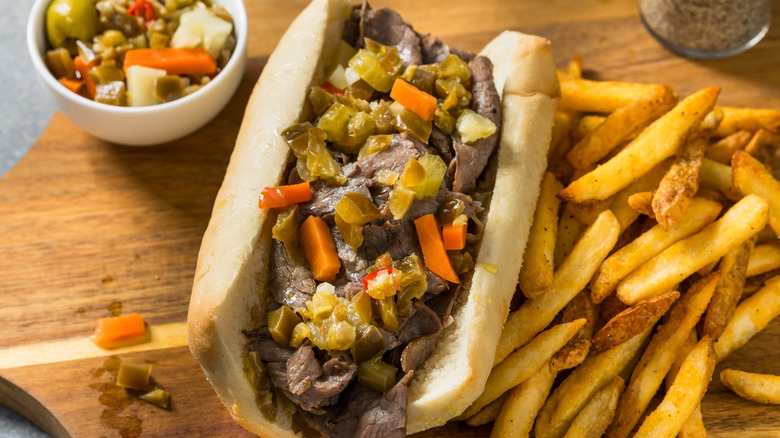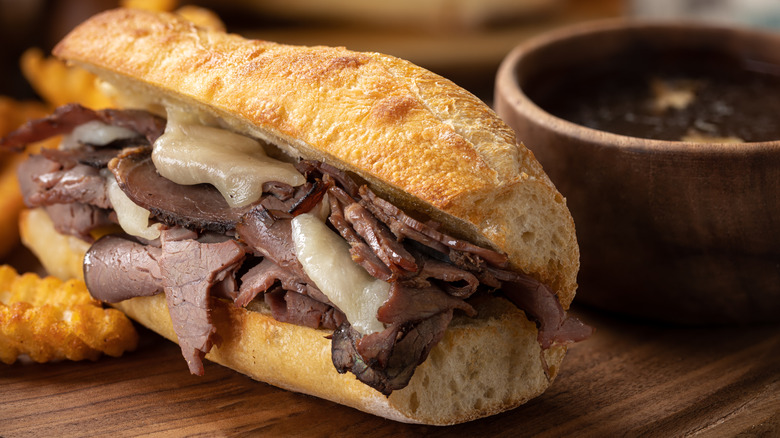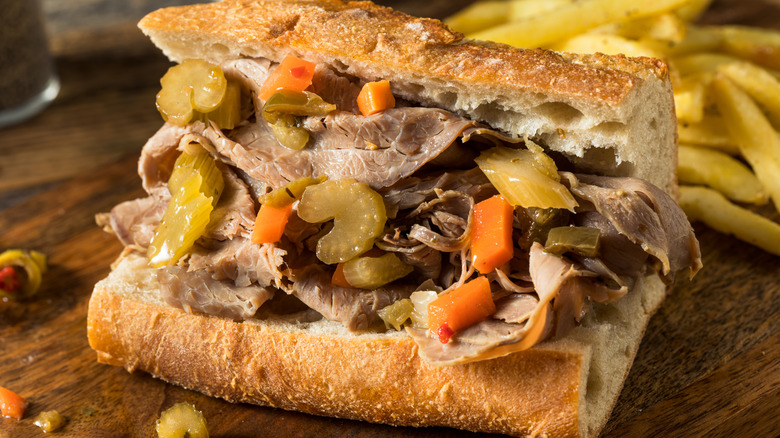Italian Beef Vs French Dip: How These Sandwiches Differ
Since the sandwich was seemingly popularized by the fourth Earl of Sandwich in late 18th century England, it has become a staple in the American diet. The average person eats six sandwiches a week (per a Talker Research study commissioned by Buddig), and 42% take care to use quality ingredients and craft the perfect dish. With that in mind, it makes sense for many restaurants to feature sandwiches on the menu. Two crafted options that may be confused, though, are a couple of the most iconic sandwiches in U.S. states: the French dip from California and the Italian beef from Illinois.
Despite both having different origins in the early 1990s, the similarities between the Italian beef and French dip sandwiches are what make unfamiliar diners mistake one for the other. They both feature roast beef and can be messy because of the jus served with them (serving a dish "au jus" means it comes with a sauce made from the meat's own juices left over after roasting). In fact, the juice-intensive characteristics of these sandwiches are one reason why they're so loved in their respective cities of origin. However, the types of breads and toppings used are what really separate French dip and Italian beef sandwiches apart.
What is a French dip sandwich?
The exact origin story of the French dip sandwich is murky because of conflicting stories, but one thing is for sure: French dip sandwiches aren't actually French. Definitely invented in Los Angeles, the sandwich either got its name from the potential creator — French immigrant Philippe Mathieu — or the fact it's made with a French roll. The French roll, or baguette, is a key difference from the Italian beef sandwich. This crusty bread doesn't fall apart as it soaks up the jus and has the same oval shape and soft interior texture of French bread.
The French dip sandwich is most commonly filled with thinly sliced roast beef, but some restaurants offer variations made with ham, lamb, pork, or turkey. The cut of choice for a slow-cooker French dip sandwich is generally bottom-round roast, but fattier cuts such as beef chuck roast and prime rib roast also work. In addition to salt and pepper, the roast can be seasoned with oregano and thyme and cooked with garlic and onions. The filling of a French dip may also feature cheese (such as Swiss or provolone) and various condiments (typically spicy mustard). The drippings are used to create a thin sauce (the jus) that is either served on the side or used to serve the sandwich in various degrees of wetness just before serving. Especially at Philippe the Original, a single dip means dipping just the top half of the roll in jus, while a double dip means both halves are dipped. Ordering the sandwich wet, though, means both halves are left in the jus longer.
What is an Italian beef sandwich?
The origin of the Italian beef sandwich is only slightly clearer, starting in Chicago's Little Italy. Roast beef was sliced thinly and cooked in its juices to feed more people at "peanut weddings," an Italian-American tradition (which explains the "Italian" in its name). While the who behind the idea is disputed since many people in the neighborhood were doing it, there's a bit of an art to making a truly mouthwatering Italian beef sandwich.
A top round roast or sirloin tip roast is usually seasoned with black and red pepper, cloves, garlic, basil, and oregano. After cooking in beef stock, it's cooled and sliced as thin as possible, potentially into ribbons. The leftover broth and jus are reheated, and letting the sliced beef swim in it is a step you shouldn't skip when making Italian beef sandwiches. Forkfulls of the beef are placed into "French bread" — as Chicago-based Italian bakeries called it to distinguish it from their bread. Compared to the French dip sandwich roll, it has a thinner crust and a softer, fuller crumb.
One of the defining differences with the Italian beef sandwich, though, is the peppers on top. While sweet peppers are generally an option, the traditional way to order it is hot with giardiniera (a blend of pickled spicy peppers and vegetables). Some people also like to add cheese (commonly provolone), but this isn't traditional. Unlike the French dip, the sandwich isn't served au jus on the side. Instead, it's served in various levels of wetness: Dry means the juice is shaken off the meat, dipped means a quick dip in the jus, and wet means the sandwich is submerged longer, then tightly wrapped in foil or wax paper.


